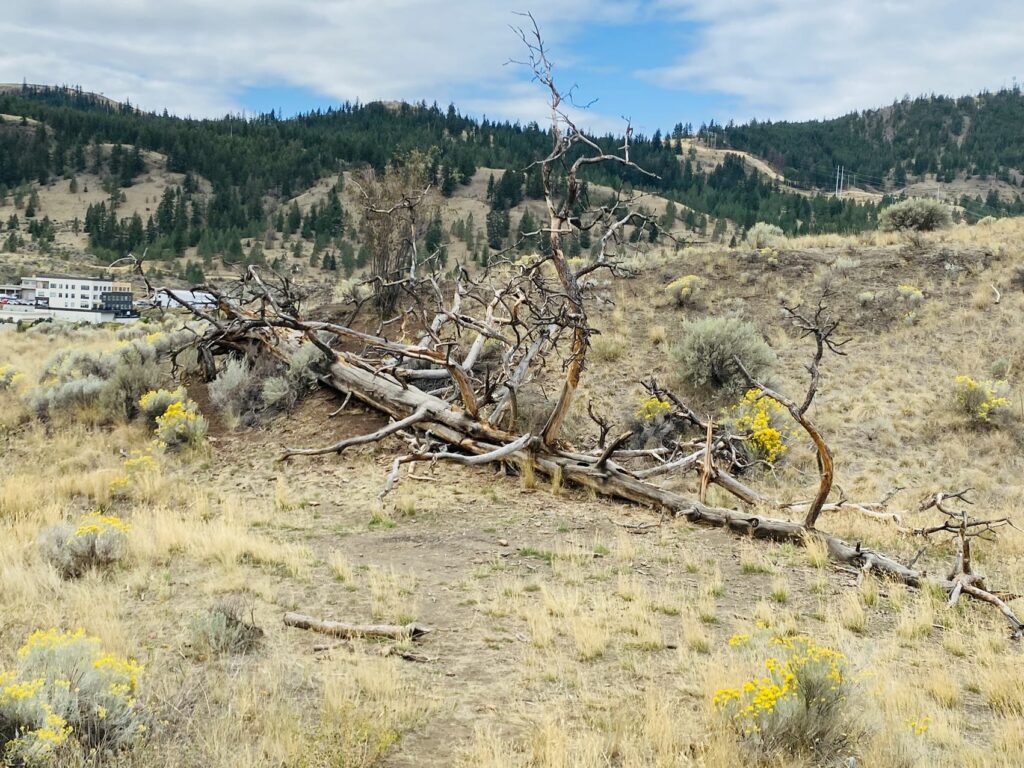“M in the head, Y at the back”- two adults at the beginning and end of the line, six children in a line- a group of eight, headed to the TRU hills to explore the “pirate ship”.
Earlier, after snack time, M had asked each child individually, “Would you like to stay inside or go outside?” Several children chose to go out, shaping the next activity.
Once they arrived, two boys quickly climbed a tree, challenging themselves with shouts and pirate-inspired play. One boy pulled down a large branch, declaring it to be a T-rex. However, the girls didn’t join him, and he soon abandoned the branch.
Meanwhile, the girls focused on building a “cactus home.” They gathered cacti and placed them at a previously decorated spot. Yes, they were playing with cacti—a prickly plant! M discovered a cluster of dry but still-living cactus nearby and brought it to the children’s attention. She demonstrated how sharp the prickles were by touching them with mittens, then used two sticks to show how to handle the cacti safely.
E, one of the girls, was initially hesitant. Before M’s demonstration, E had slapped a cactus with her mitten-covered hand, much like how children sometimes knock over blocks. When I asked, “Do you want to take some cactus?” she replied, “No.” I suspected this was because she lacked the confidence or skills to handle it. So, I gently picked up a cactus with my mittened hand and asked, “Do you want to take this one?” She agreed and carefully carried it to the cactus home.
Afterward, she eagerly transported more cacti to the spot, and eventually began using two sticks to move them. E had learned a new skill!
Another girl, P, focused on decorating the cactus home. M had placed some weeds around it earlier, and P insisted they should remain untouched. She decided to add a “semi-circle” of decoration. P tried using dry sticks but grew frustrated when they wouldn’t bend. M reassured her, saying, “Nature sometimes provides things just as they are.” This calmed Penny and she found stones instead soon.
P worked enthusiastically, singing with M to the tune of “The Wheels on the Bus.” She even created new lyrics when she sang and hit the rocks:
“The rock says bang bang, bang bang bang,
The rock says bang bang bang, all through the town.”
Nearby, N found a large stick and began hitting a tree, pretending to be a dragon warrior. M reminded her, “If you hit the tree, you need to look around first to make sure no one is nearby.” N listened quietly and moved to a safer area, holding onto the stick and continuing her play.
While most children were deeply engaged in exploration, C stayed close to M When she grew tired, she sadly said, “Mommy!” M comforted her by saying, “C, I know you miss your family, but they’ll pick you up in a few hours.” To address C’s growing anxiety, Mary decided it was time to lead the group back to the care center.
As the group descended the hill, E lingered with me, pretending we were driving down the hill. She made vroom-vroom sounds, and I joined in, pretending to steer an imaginary car.
M explained her approach to emergent curriculum: “It’s about listening to children’s rhythms and flows, responding to their ideas, and living real life alongside them.” I think I have experienced a vivid lesson of emergent curriculum.
